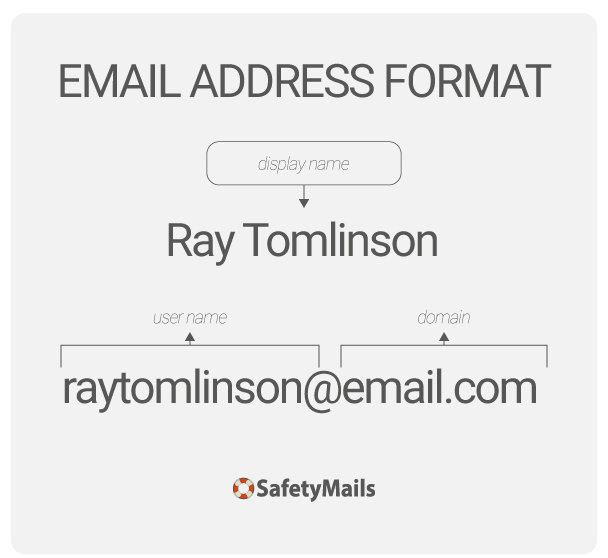Valid email formats are very important for marketers who work using registration forms in their strategies.
If the email formats (also called email syntax) are not valid, the entire contact list is compromised.
Email syntax is the basic standardization of the elements that make up an address, i.e.: the user’s name, followed by the @ symbol and the domain name with an extension (.com; .com.br; .org etc.).

Table of contents
How emails with syntax errors harm email marketing senders
Emails with syntax errors become invalid addresses, as flaws in the formatting of the address make the email non-existent. It is therefore impossible to communicate with a recipient who does not exist.
These errors in the formatting of the email address come, in the majority of cases, from typos; which happens a lot when someone fills in a registration form using a smartphone, for example.
Who hasn’t typed “Gamil” instead of “Gmail”? Or a username that doesn’t exist because you reversed the position of two letters?
How to solve the problem of invalid email formats in forms
Real-time email verification prevents emails with syntax errors from entering the registration forms.
The verification API, which integrates with various data collection services (websites, landing pages, forms, etc.) , identifies addresses with errors and does not accept them in the forms.
By recognizing emails with typos in more common domains, the API can suggest corrections, presenting the expression “did you mean”.
And if the error occurs in the username (which characterizes a non-existent and therefore invalid email), the API asks the user to enter a valid email so that they can download, access the material provided by the form or finish their registration.
Now that you’ve seen how important email verification is for building a healthy contact list, let’s learn how to recognize the structure of an email address.
Email formats: user name
Located before the “@” symbol and identifies the person or function of the email address in the domain.
May contain
- Letters from A to Z
- Numbers from zero to 9
- Special characters: underscore, period and hyphen. Any of these characters must be followed by a letter or a number.
What is not allowed in the user name
- Period before or after the name (e.g.: [email protected])
- More than one sequential period (e.g.: [email protected])
- Special characters other than underscore, period and hyphen (e.g. paul#@domain.com).
Email formats: the @ symbol
It’s the sign that separates the user’s name from the domain name.
The first emails to have this configuration occurred in 1971, when engineer Ray Tomlinson created the first email system that allowed messages to be sent between different computers on a network.
Tomlinson inserted the @ to separate the user name from the domain. In this way, the recipients could know where the messages were coming from.
Email formats still follow this structure today.

The domain name
May contain
Letters from A to Z
Numbers from zero to 9
Special characters: only the hyphen, but it cannot be used at the beginning or end of the domain name
Domain extension
The domain extension comes last in a website’s address. Correct extensions give an indication of the site’s purpose or geographical location.
For example, a website with a .com.br extension is from Brazil. A site with a .com.pt extension is from Portugal and so on.
In addition, the final part of the domain also has the function of identifying the purpose of the site. For example, a .gov.br extension indicates that the Government of Brazil owns the site.
The same goes for a .org.br extension, which indicates that the owner is a Brazilian association, foundation or NGO.
There are numerous domain extensions, such as: .com | .online | .net. Here’s how they look technically.
In email formats, extensions are segmented in the following order
Sponsored top-level domains
Domains sponsored by a specific entity that establishes rules and restrictions for their use. For example:
- .gov – Government
- .edu – Educational institutions
Generic top-level domains
These are the most common domains and are not restricted to a specific geographical location:
- .com – Comercial
- .org – Organizations (usually non-profit)
- .net – Networks
- .info – Informations
- .tech – Tecnology
- .shop – Comerce
- .blog – Blogs
- .app – Applications
- .design – Design
Top-level domains with country code
These domains are assigned to specific countries and usually have two letters:
- .us – United States
- .uk – United Kingdom
- .de – Germany
- .jp – Japan
- .br – Brazil
Second level domains
In addition to the top level, some countries use a second level to further specify the purpose of the site. For example:
- .org.uk – Organizations in the UK
- .edu.au – Educational institutions in Australia
- .com.br – Commercial in Brazil
In email formats, each type of domain extension serves different needs and contexts, offering many options for individuals and organizations when choosing their web addresses.
Corporate email formats
Exclusive domain
First of all, we need to understand that a professional email must have good email hosting with its own domain, i.e. the company name registered on its website.
This provides all the credibility a company needs. For example: [[email protected]] is an exclusive domain. Unlike [[email protected]], which is a public domain.
In addition, professional emails have their own signature, which is fundamental to the reputation of email senders. For example, when sending an abandoned cart recovery email, the message is instantly recognized by the customer.
And speaking of reputation, your own domain offers the possibility of working with email marketing, since email automation platforms accept corporate addresses as senders.
The same goes for recipient providers, who only accept professional emails as bulk email senders.
Username and information security
The choice of username for corporate emails can have an impact on information security.
Common usernames, such as admin@; financial@ etc. can be used in phishing attacks, where the scammer carries out a dictionary attack to send a fake email, increasing the likelihood of the victim clicking on malicious links or providing confidential information. A recommendation is to use the username + position, not just the position.
Bonus tip: how to discover corporate email formats to build a list
Corporate mailing lists mean you can scale your business. And getting those emails is what every email marketing professional wants.
SafetyMails offers a free search service for corporate email formats to help sales and marketing teams build their lists.
This service offers some possible email structures for a company.
For example:
- First name +.+Last name | Ex.: [email protected]
- First name +.+ Letter +. + Last name | Ex.: [email protected]
- First name | Ex.: [email protected]

Conclusion: the importance of correct syntax
The correct syntax of emails in registration forms is essential to ensure the effective delivery of messages, protect against security threats and maintain a high level of professionalism in communication.
An incorrect address can result in messages not being delivered or sent to the wrong recipient. This damages the sender’s reputation, especially in professional environments.
In addition, poorly formatted email addresses can expose flaws and vulnerabilities in authentication and validation systems. Hackers exploit these loopholes to carry out phishing attacks, identity theft and other malicious activities.
Implementing the real-time verification API prevents many of these problems, guaranteeing a positive experience for both users and organizations.
FAQ
What does email syntax mean?
Email syntax is the basic formatting present in all email addresses: user name+@+domain name+extension. Email formats that do not follow this standard are harmful to email marketing lists, as they are non-existent and therefore invalid addresses.
And a list containing invalid addresses is blocked by the recipients’ ISPs, damaging the senders’ reputation.
How does the verification API prevent emails with syntax errors from entering the forms?
The API, which is integrated with various email collection services, identifies emails with typos in the user’s name and asks them to enter a valid address so that they can continue with their activities and access the material provided by the form.
If the error is in the domain name, the API automatically corrects it by displaying the “did you mean”, so that the email address can be filled in correctly. In this way, the lists collected from the registration forms are much more likely to reach the recipients’ inbox, representing real business opportunities for the sales and marketing teams.



